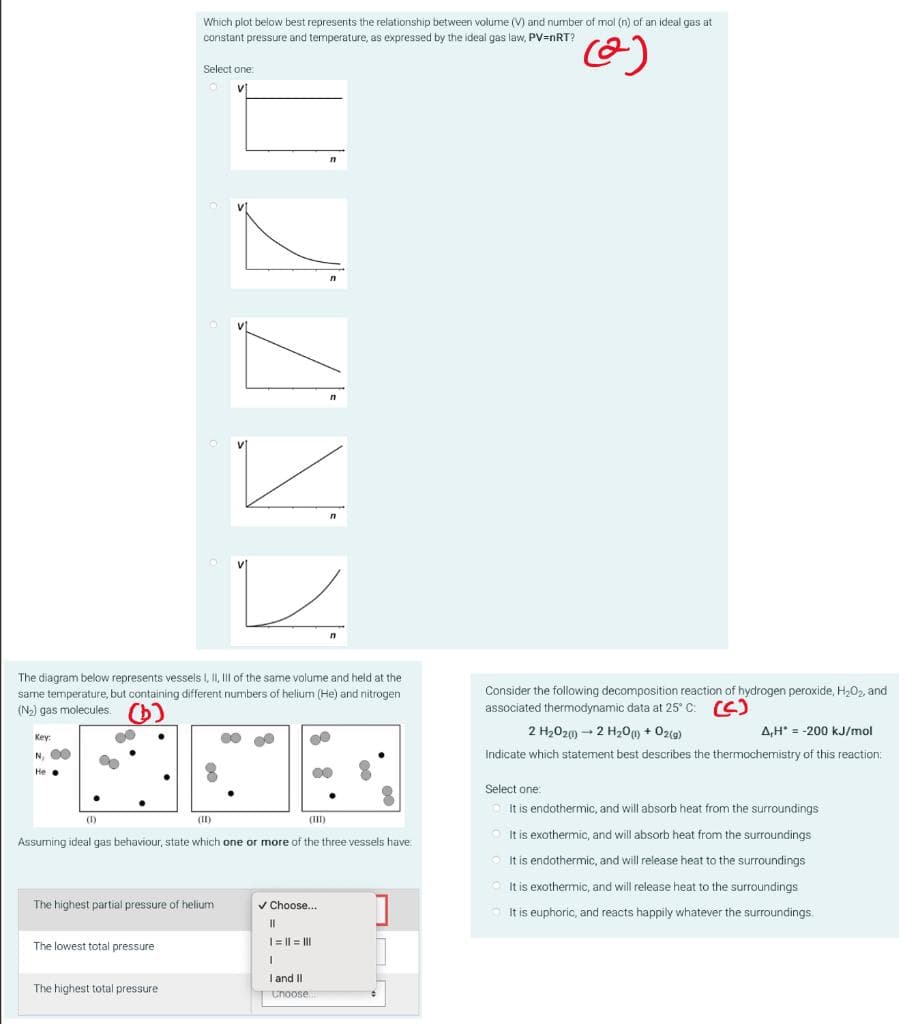Which plot below best represents the relationship between volume (V) and number of mol (n) of an ideal gas at constant pressure and temperature, as expressed by the ideal gas law, PV=nRT? (2) Select one: v VI Consider the following decomposition reaction of hydrogen peroxide, H₂O₂, and associated thermodynamic data at 25° C: (C) 2 H₂O2(1)→ 2 H₂0 (1) + O2(g) A,H* = -200 kJ/mol Indicate which statement best describes the thermochemistry of this reaction: Select one: It is endothermic, and will absorb heat from the surroundings. It is exothermic, and will absorb heat from the surroundings It is endothermic, and will release heat to the surroundings It is exothermic, and will release heat to the surroundings It is euphoric, and reacts happily whatever the surroundings. n n The diagram below represents vessels I, II, III of the same volume and held at the same temperature, but containing different numbers of helium (He) and nitrogen (N₂) gas molecules. Key: 00 N, He (II) (III) Assuming ideal gas behaviour, state which one or more of the three vessels have The highest partial pressure of helium ✓ Choose... II The lowest total pressure | = || = ||| I I and II The highest total pressure Choose
Which plot below best represents the relationship between volume (V) and number of mol (n) of an ideal gas at constant pressure and temperature, as expressed by the ideal gas law, PV=nRT? (2) Select one: v VI Consider the following decomposition reaction of hydrogen peroxide, H₂O₂, and associated thermodynamic data at 25° C: (C) 2 H₂O2(1)→ 2 H₂0 (1) + O2(g) A,H* = -200 kJ/mol Indicate which statement best describes the thermochemistry of this reaction: Select one: It is endothermic, and will absorb heat from the surroundings. It is exothermic, and will absorb heat from the surroundings It is endothermic, and will release heat to the surroundings It is exothermic, and will release heat to the surroundings It is euphoric, and reacts happily whatever the surroundings. n n The diagram below represents vessels I, II, III of the same volume and held at the same temperature, but containing different numbers of helium (He) and nitrogen (N₂) gas molecules. Key: 00 N, He (II) (III) Assuming ideal gas behaviour, state which one or more of the three vessels have The highest partial pressure of helium ✓ Choose... II The lowest total pressure | = || = ||| I I and II The highest total pressure Choose
Chemistry
10th Edition
ISBN:9781305957404
Author:Steven S. Zumdahl, Susan A. Zumdahl, Donald J. DeCoste
Publisher:Steven S. Zumdahl, Susan A. Zumdahl, Donald J. DeCoste
Chapter1: Chemical Foundations
Section: Chapter Questions
Problem 1RQ: Define and explain the differences between the following terms. a. law and theory b. theory and...
Related questions
Question
3

Transcribed Image Text:Which plot below best represents the relationship between volume (V) and number of mol (n) of an ideal gas at
constant pressure and temperature, as expressed by the ideal gas law, PV=nRT?
(2)
Select one:
v
VI
Consider the following decomposition reaction of hydrogen peroxide, H₂O₂, and
associated thermodynamic data at 25° C: (C)
2 H₂O2(1)→ 2 H₂0 (1) + O2(g)
A,H* = -200 kJ/mol
Indicate which statement best describes the thermochemistry of this reaction:
Select one:
It is endothermic, and will absorb heat from the surroundings.
It is exothermic, and will absorb heat from the surroundings
It is endothermic, and will release heat to the surroundings
It is exothermic, and will release heat to the surroundings
It is euphoric, and reacts happily whatever the surroundings.
n
The diagram below represents vessels I, II, III of the same volume and held at the
same temperature, but containing different numbers of helium (He) and nitrogen
(N₂) gas molecules.
Key:
N,
He S
(II)
(III)
Assuming ideal gas behaviour, state which one or more of the three vessels have
The highest partial pressure of helium
✓ Choose...
II
The lowest total pressure
| = || = |||
I
I and II
The highest total pressure
Choose
Expert Solution
This question has been solved!
Explore an expertly crafted, step-by-step solution for a thorough understanding of key concepts.
Step by step
Solved in 2 steps with 1 images

Knowledge Booster
Learn more about
Need a deep-dive on the concept behind this application? Look no further. Learn more about this topic, chemistry and related others by exploring similar questions and additional content below.Recommended textbooks for you

Chemistry
Chemistry
ISBN:
9781305957404
Author:
Steven S. Zumdahl, Susan A. Zumdahl, Donald J. DeCoste
Publisher:
Cengage Learning

Chemistry
Chemistry
ISBN:
9781259911156
Author:
Raymond Chang Dr., Jason Overby Professor
Publisher:
McGraw-Hill Education

Principles of Instrumental Analysis
Chemistry
ISBN:
9781305577213
Author:
Douglas A. Skoog, F. James Holler, Stanley R. Crouch
Publisher:
Cengage Learning

Chemistry
Chemistry
ISBN:
9781305957404
Author:
Steven S. Zumdahl, Susan A. Zumdahl, Donald J. DeCoste
Publisher:
Cengage Learning

Chemistry
Chemistry
ISBN:
9781259911156
Author:
Raymond Chang Dr., Jason Overby Professor
Publisher:
McGraw-Hill Education

Principles of Instrumental Analysis
Chemistry
ISBN:
9781305577213
Author:
Douglas A. Skoog, F. James Holler, Stanley R. Crouch
Publisher:
Cengage Learning

Organic Chemistry
Chemistry
ISBN:
9780078021558
Author:
Janice Gorzynski Smith Dr.
Publisher:
McGraw-Hill Education

Chemistry: Principles and Reactions
Chemistry
ISBN:
9781305079373
Author:
William L. Masterton, Cecile N. Hurley
Publisher:
Cengage Learning

Elementary Principles of Chemical Processes, Bind…
Chemistry
ISBN:
9781118431221
Author:
Richard M. Felder, Ronald W. Rousseau, Lisa G. Bullard
Publisher:
WILEY